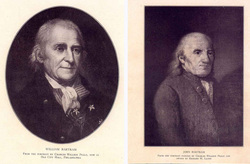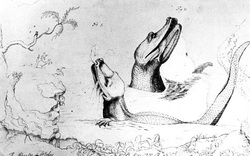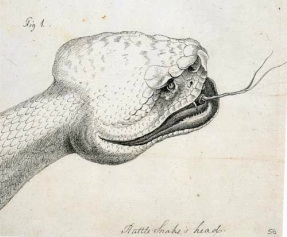April 10, 1766 - John Bartram ends journey to Carolinas, Ga., Florida
 William (left) and John Bartram
William (left) and John Bartram
The founder of modern naturalism and botany officially concluded his journey through the Carolinas, Georgia and Florida on this date in 1766. We know this because it's part of the title of a John Bartram manuscript, "Diary of a Journey Through the Carolinas, Georgia and Florida, from July 1, 1765 to April 10, 1766" published as part of the series, Transactions of the American Philosophical Society in 1942.
John Bartram was a Quaker and highly-regarded botanist who traveled the wilderness of the American colonies with a goal of documenting all the natural flora of the New World. In 1765, when he was in his 60s, King George III named him the Royal Botanist in America and sent him with his 26-year-old son, William, to explore East and West Florida, which had been ceded to England by Spain two years earlier. Florida had become the subject of fascination in London and potential investors were seeking information about developable lands.
John Bartram was a Quaker and highly-regarded botanist who traveled the wilderness of the American colonies with a goal of documenting all the natural flora of the New World. In 1765, when he was in his 60s, King George III named him the Royal Botanist in America and sent him with his 26-year-old son, William, to explore East and West Florida, which had been ceded to England by Spain two years earlier. Florida had become the subject of fascination in London and potential investors were seeking information about developable lands.
 Alligators sketched by William Bartram
Alligators sketched by William Bartram
After traveling through the Carolinas and Georgia on horseback, the Bartrams spent nearly two months exploring the St. Johns River by canoe. John analyzed the quality of soil, plants and trees along the river, while William sketched pictures of plants and animals they saw. Afterward, John stayed in St. Augustine and converted his diary entries into a travel journal that was widely read in England and inspired aristocrats and merchants to acquire tracts of land in East Florida. Those investments led to the plantation era in Florida, which irrevocably changed the face of the river valley that the Bartrams had so carefully observed and recorded.
 Rattlesnake head sketched by William Bartram
Rattlesnake head sketched by William Bartram
William returned to East Florida in 1774 and spent eight months traveling the St. Johns River in a small sailboat. In 1991, he published his own journal, Travels Through North and South Carolina, Georgia, East and West Florida, the Cherokee Country, the Extensive Territories of the Muscogulgees, or Creek Confederacy, and the Country of the Chactaws. Sections of that book recounting William's Florida travels were widely read throughout Europe and helped shape the romanticized view of the state's natural treasures that continues to inspire explorers today.
Read more about the Bartrams' travels through Florida:
• Florida History Online: John Bartram’s Travels on the St. Johns River, 1765-1766
• Florida Museum of Natural History: Florida Naturalists - William Bartram
• Bartram's Garden - 18th Century Home of John Bartram Naturalist & Botanist & Explorer.
• Florida History Online: John Bartram’s Travels on the St. Johns River, 1765-1766
• Florida Museum of Natural History: Florida Naturalists - William Bartram
• Bartram's Garden - 18th Century Home of John Bartram Naturalist & Botanist & Explorer.
